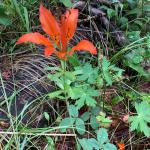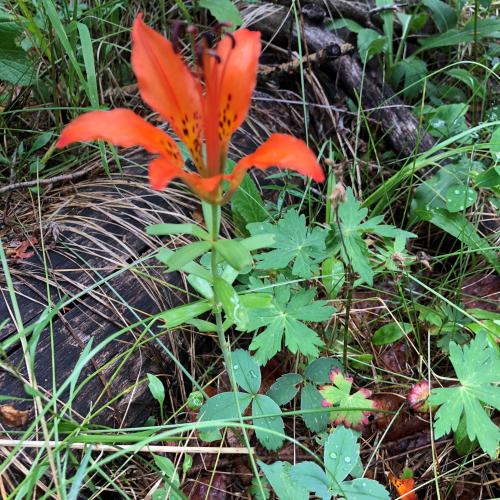Lilium philadelphicum var. andinum (Mountain Lily)
LILIUM ANDINUM; LILIUM MONTANUM; L. VAR. MONTANUM; LILIUM UMBELLATUM
| USFWS | State of NM | USFS | BLM | Navajo Nation | State Rank | Global Rank | R-E-D Code | NMRPTC Status | Strategy Status |
|---|---|---|---|---|---|---|---|---|---|
| E | S3 | G5T4T5 | SS |
| Overall Conservation Status | Documented Threats | Actions Needed |
|---|---|---|
| EFFECTIVELY CONSERVED | Collection |
Status surveys on abundance, distribution and threats |
Bulbs chunky, 1.6–2.9 × 2.2–4.7 cm, 0.6–1.1 times taller than long, 2(–4) years’ growth visible; scales 1–2-segmented, longest 1.2–2.2 cm; stem roots present or absent. Stems to 1.2 m, glaucous. Buds rounded in cross section. Leaves scattered, or mostly scattered with at least 1 distal whorl, or in 1–5 whorls or partial whorls, 3–11 leaves per whorl, ± horizontal and drooping at tips, or ascending in sun, 2.9–10.2 × 0.3–2.3 cm, 3.5–18 times longer than wide; blade narrowly elliptic, sometimes linear, elliptic, or oblanceolate, margins not undulate, apex acute or barely acuminate; veins and margins ± smooth abaxially. Inflorescences umbellate, 1–3(–6)-flowered. Flowers erect, not fragrant; perianth widely campanulate; sepals and petals somewhat recurved 1/4–2/5 along length from base, red-orange or red-magenta, sometimes pale orange, pure red, or rarely yellow, distinctly clawed, apex often widely acute, rarely obtuse, nectar guides above claws yellow to orange and spotted maroon, more pronounced on sepals; sepals not ridged abaxially, 4.9–8.2 × 1.6–2.6 cm; petals 4.5–7.7 × 2–3.2 cm; stamens strongly exserted; filaments ± parallel to style, barely spreading, diverging 0°–8° from axis, ± same color as sepals and petals; anthers dull maroon, 0.5–1.2 cm; pollen variously colored dark orange, brown, brown-yellow, or yellow; pistil 5–8 cm; ovary 1.3–3.2 cm; style ± same color as sepals and petals; pedicel 2.5–10.5 cm. Capsules 2.2–7.7 × 1–1.8 cm, 3–4.8 times longer than wide.
Flowering late spring--summer (late May--Aug),
New Mexico: Sandoval, Otero, Santa Fe, San Miguel, Los Alamos, Colfax counties. Widespread in Canada and the United States.
Moist woodlands and meadows in mixed conifer forests and canyon bottoms, between 7,550 and 10,000 ft.
According to the Flora of North America vegetative and fruit morphology of Lilium philadelphicum is determined by local environment to a great degree. The characters supporting the var. andinum—especially capsule length—vary continuously and somewhat independently. Therefore, the status of var. andinum is unsettled and it is not accorded formal recognition in the FNA.
Lilium philadelphicum is rather widespread throughout the United States and Canada and is the widest ranging of our true lilies. Although rather common in high meadows of the mountain west and some intact tallgrass prairies of the Great Plains and adjacent corn belt, it is decidedly rare to the east in lower midwestern prairies of the United States and in the southern Appalachians, where it is protected by several states. It has declined rapidly in the northeastern United States as prairies disappear and white-tailed deer increase in number. In New Mexico it is seldom seen and is listed Endangered by the State due to collection pressure.
Skinner, Mark W. Lilium. In: Flora of North America Editorial Committee, eds. 1993+. Flora of North America North of Mexico [Online]. 21+ vols. New York and Oxford. Vol. 26. http://www.efloras.org/florataxon.aspx?flora_id=1&taxon_id=118558
For distribution maps and more information, visit Natural Heritage New Mexico


